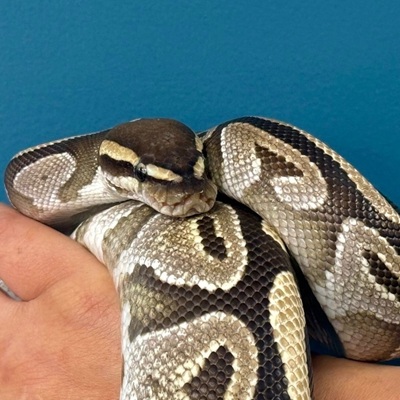
Even though the Year of the Snake doesn’t end until next February, *this* February is coming to an end. That means we need to bid a fond farewell to this month’s featured creature, the ball python. If you have been following our Animal of the Month feature on “X” (a.k.a. Twitter) and Threads, you will have seen lots of fascinating facts about ball pythons that we posted throughout February. But if you happened to miss any, you can find a summary right here. Did you know?:
- Ball pythons (Python regius) are medium-sized snakes and are the smallest of the eight species of pythons that are endemic to Africa.
- In the wild, ball pythons are found across a wide swath of western and central sub-Saharan Africa.
- Ball pythons can be found in parts or all of Senegal, Guinea, Guinea-Bissau, The Gambia and Sierra Leone in the most western parts of their range.
- From those countries, the ball pythons’ natural range stretches across about a dozen other western and central African countries, ending in South Sudan and Uganda as the most easterly points in Africa where they can be found.
- In the wild, ball pythons live in both semi-arid and humid habitats. They can be found in open woodlands and savannahs, which are open grasslands sparsely populated by trees.
- Ball pythons are also found in agricultural areas, where they have a positive economic impact on farmers because they help control the rodent population.
- Ball pythons avoid living in extremely arid environments. While found in much of Burkina Faso, they are reportedly absent in areas of the country that don’t receive more than 60 cm of rain annually.
- When fully grown, ball pythons reach an average length of about 1.2 metres (4 feet). Females are usually bigger than males.
- Ball pythons have stocky bodies that are naturally black and/or dark brown with lighter brown/tan blotches. Their bellies are usually white or cream-coloured.
- The natural colour and patterns on their skin give ball pythons effective camouflage in the wild.
- Ball pythons have flat heads and square snouts. They also typically have a stripe on each side of their eyes. These stripes also aid in camouflage as they visually break up the outline of their heads.
- Years of captive breeding have resulted in ball pythons with different colours and patterns that are referred to as morphs. These morphs include – but are not limited to – pastel, pied, albino and axanthic.
- Male ball pythons will reach sexual maturity between 12 – 18 months of age. Females take much longer and don’t reach sexual maturity until they are between two- and three-years-old.
- Female ball pythons usually lay clutches averaging between 6 and 10 eggs. They will lay their eggs in an underground burrow.
- The female ball python will wrap herself tightly around her egg clutch in order to incubate them and protect them from predators.
- The eggs usually take about two months to hatch. The ball python hatchlings are independent when they are born.
- Ball pythons are ambush predators; meaning, they don’t chase their prey. Instead they wait for prey to cross their paths and will quickly strike out to grab their meal.
- When ball pythons successfully grab their prey, they will rapidly wrap themselves around it to squeeze the prey until it suffocates.
- Ball pythons have a series of holes above their mouths, which are pit organs that help them detect prey. Each pit organ has a membrane that can sense the heat of nearby bodies.
- Combined with their ability to see well in the dark, these pit organs help ball pythons hunt effectively at night and among foliage.
- In the wild, ball pythons will eat small mammals such as shrews, striped mice and African soft-furred rats. Males and young ball pythons will also eat nestlings and small, young birds.
- Ball pythons, particularly small juveniles, have a few predators in the wild; such as birds of prey, hyenas, wild dogs and black cobras (Naja melanoleuca).
- But the biggest threats ball pythons face come from humans through habitat destruction, pesticide use and poaching for their meat, skin and for the pet trade.
- The IUCN Red List of Threatened Species lists ball pythons as “near threatened” with their numbers in the wild decreasing overall. But the pressures on wild ball python populations can vary from country to country.
- For example, in Benin, ball pythons are under increased threats compared to some other countries in their natural range because of rampant poaching for the pet trade and bushmeat.
- Did you know that ball pythons are named after their defence mechanism? When they feel threatened, they will curl themselves into a ball.
- Ball pythons are also commonly known as royal pythons. “Regius,” which is the species (or second part) of their scientific name, means “royal” in Latin.
- The name royal python comes from the belief that some some African leaders would wear ball pythons as jewellery. Legend has it that even Cleopatra wore ball pythons as jewellery around her wrists.
- Ball pythons live an average of about 10 years in the wild. But with good care in captivity, they can easily live 20-30 years – and sometimes many years beyond that.
- In 2020, a 62-year-old ball python at the St. Louis Zoo in St. Louis, Missouri made international headlines when she laid seven eggs, which is unusual for a snake of that advanced age.
This is the second time that we have featured ball pythons as our Animal of the Month. Come on over to our blog post from November 2015 to see what we posted the first time around.

